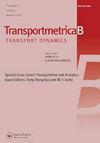基于变分LSTM的贝叶斯近似概率交通故障预测
IF 3.4
2区 工程技术
Q2 TRANSPORTATION
引用次数: 2
摘要
本文章由计算机程序翻译,如有差异,请以英文原文为准。
Probabilistic traffic breakdown forecasting through Bayesian approximation using variational LSTMs
This paper proposes a framework for short-term traffic breakdown probability calculation using a Variational LSTM neural network model. Considering that traffic breakdown is a stochastic event, this forecast framework was devised to produce distributions as outputs, which cannot be achieved using standard deterministic recurrent neural networks. Therefore, the model counts on the robustness of neural networks but also includes the stochastic characteristics of highway capacity. The framework consists of three main steps: (i) build and train a probabilistic speed forecasting neural network, (ii) forecast speed distributions with the trained model using Monte Carlo (MC) dropout, and therefore perform Bayesian approximation, and (iii) establish a speed threshold that characterizes breakdown occurrence and calculate breakdown probabilities based on the speed distributions. The proposed framework produced an efficient control over traffic breakdown occurrence, can deal with many independent variables or features, and can be combined with traffic management strategies.
求助全文
通过发布文献求助,成功后即可免费获取论文全文。
去求助
来源期刊

Transportmetrica B-Transport Dynamics
TRANSPORTATION SCIENCE & TECHNOLOGY-
CiteScore
5.00
自引率
21.40%
发文量
53
期刊介绍:
Transportmetrica B is an international journal that aims to bring together contributions of advanced research in understanding and practical experience in handling the dynamic aspects of transport systems and behavior, and hence the sub-title is set as “Transport Dynamics”.
Transport dynamics can be considered from various scales and scopes ranging from dynamics in traffic flow, travel behavior (e.g. learning process), logistics, transport policy, to traffic control. Thus, the journal welcomes research papers that address transport dynamics from a broad perspective, ranging from theoretical studies to empirical analysis of transport systems or behavior based on actual data.
The scope of Transportmetrica B includes, but is not limited to, the following: dynamic traffic assignment, dynamic transit assignment, dynamic activity-based modeling, applications of system dynamics in transport planning, logistics planning and optimization, traffic flow analysis, dynamic programming in transport modeling and optimization, traffic control, land-use and transport dynamics, day-to-day learning process (model and behavioral studies), time-series analysis of transport data and demand, traffic emission modeling, time-dependent transport policy analysis, transportation network reliability and vulnerability, simulation of traffic system and travel behavior, longitudinal analysis of traveler behavior, etc.
 求助内容:
求助内容: 应助结果提醒方式:
应助结果提醒方式:


